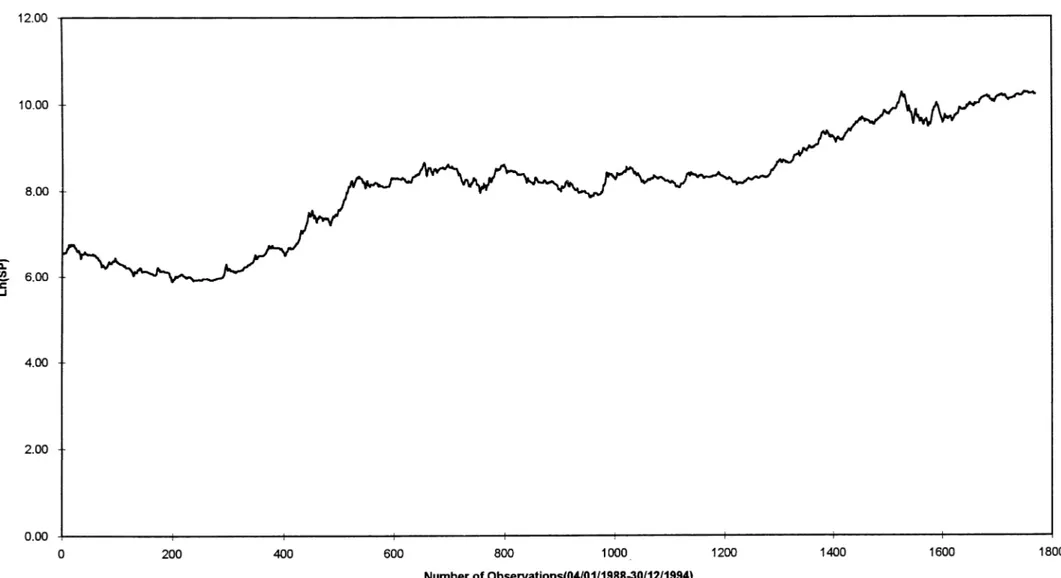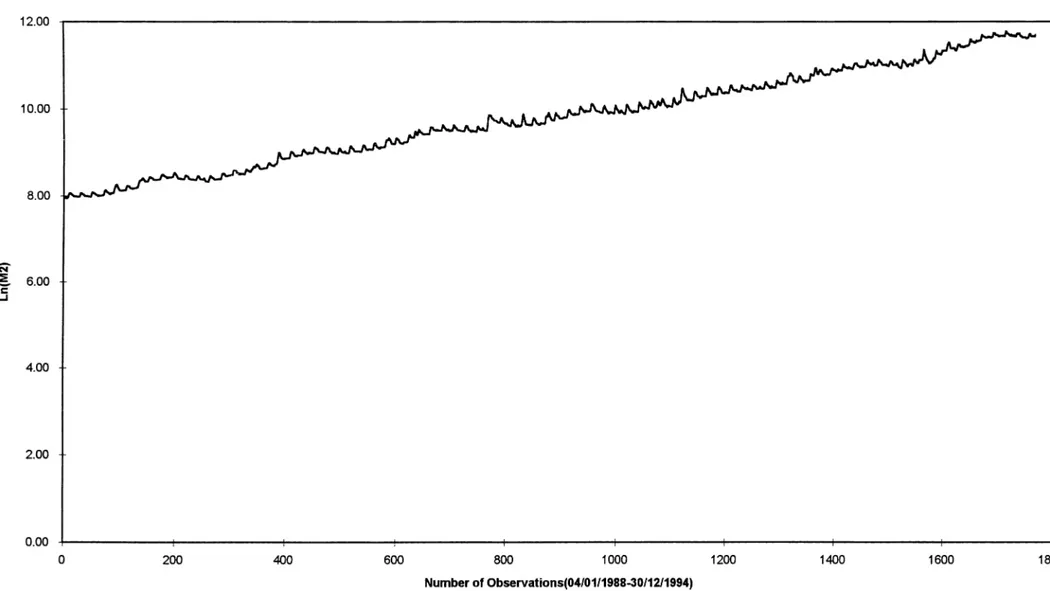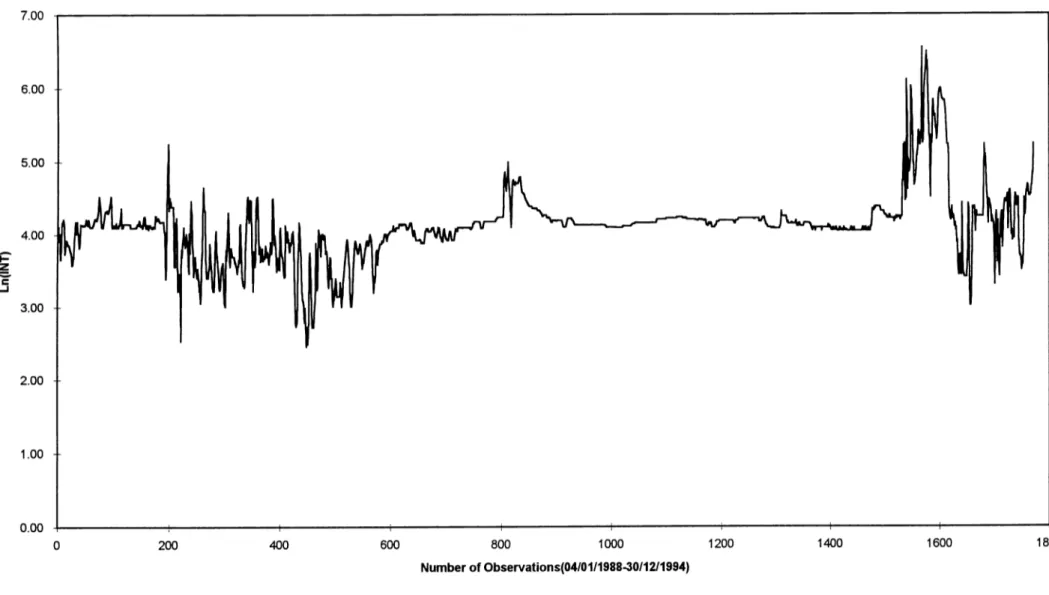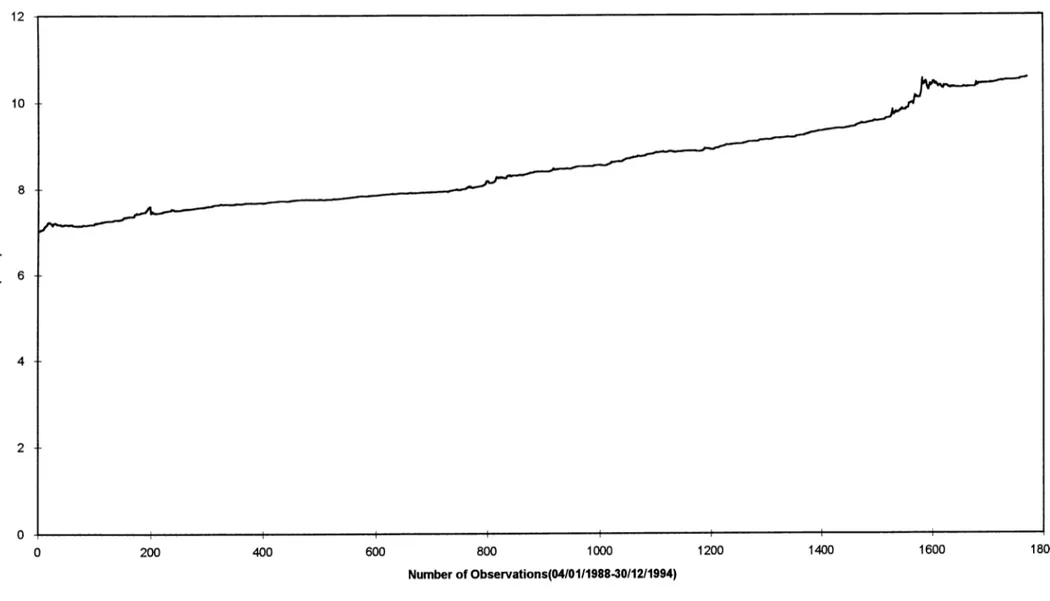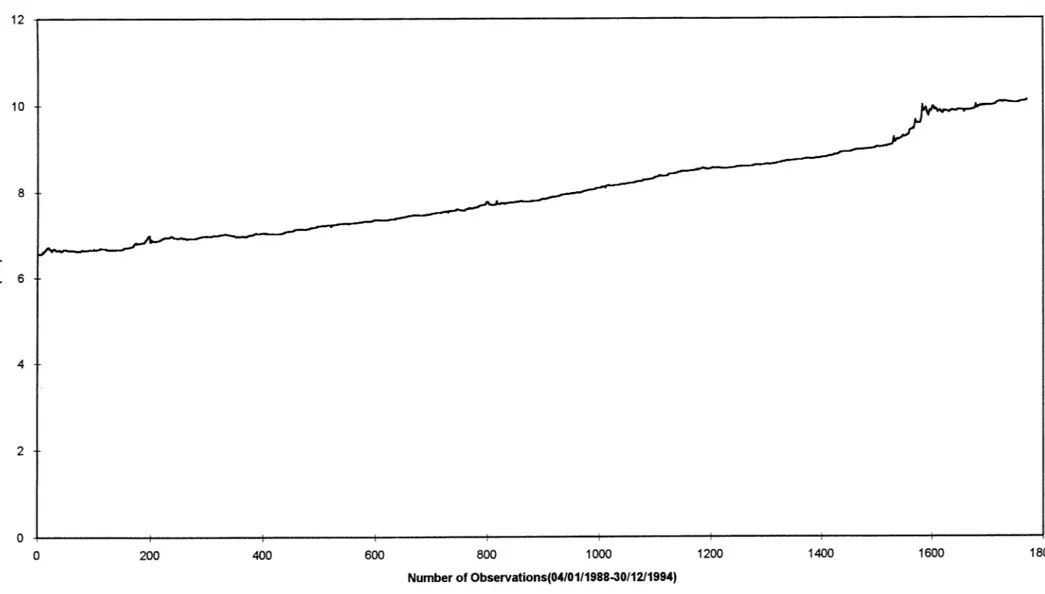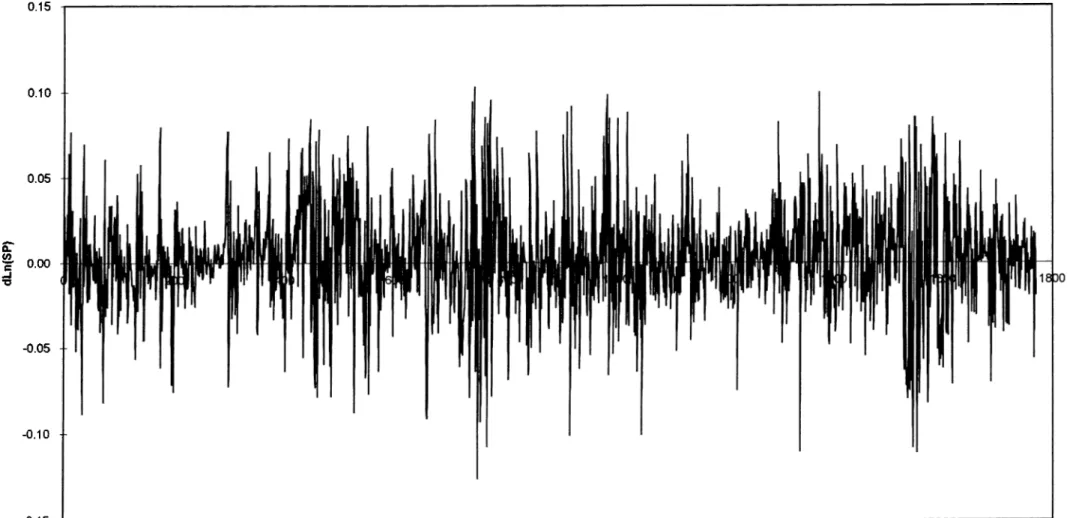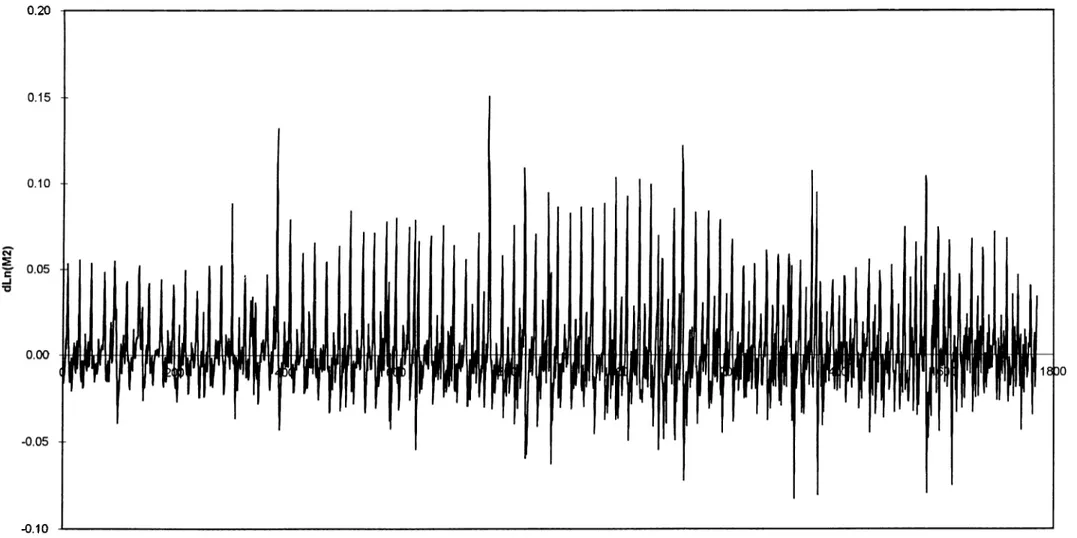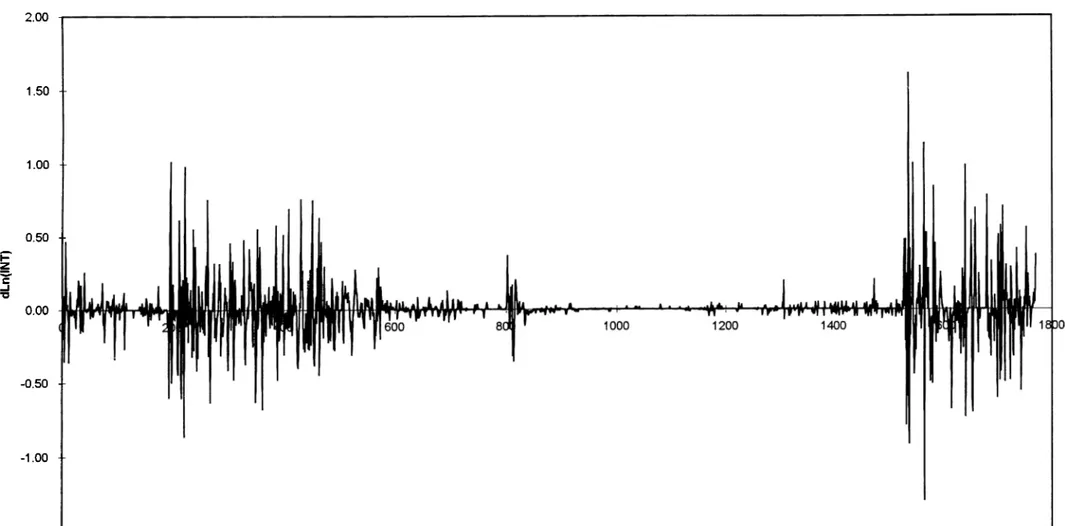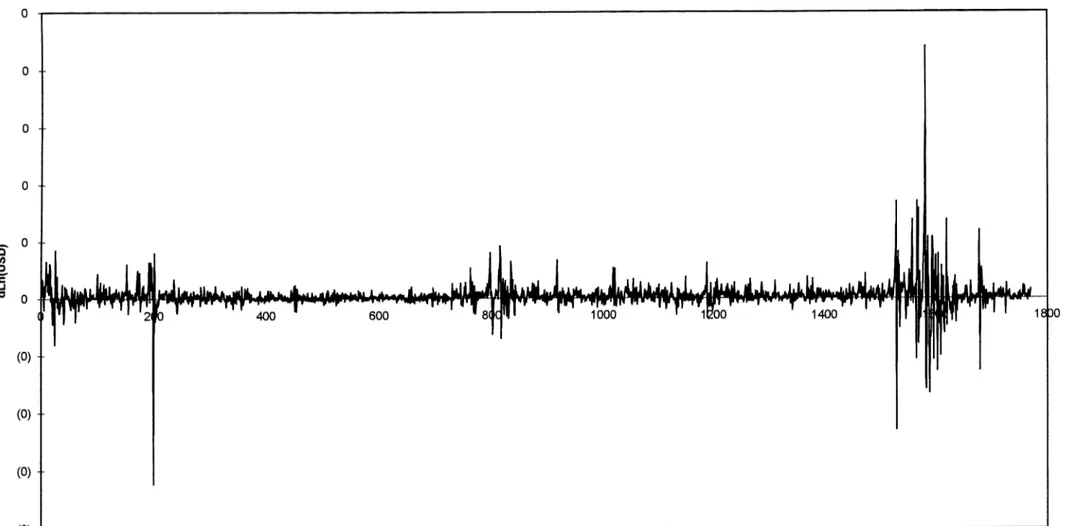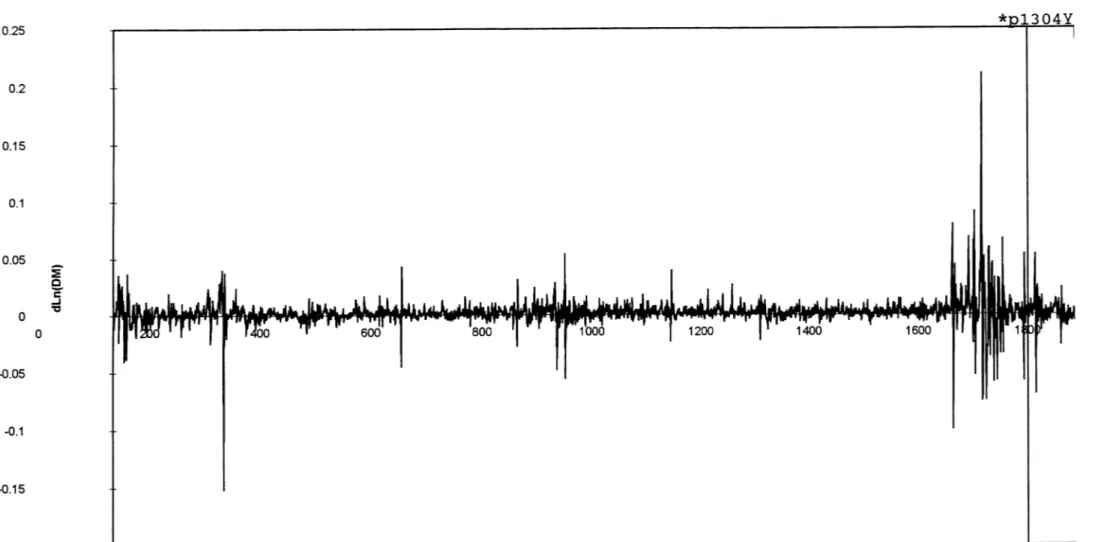♦ t T V « - J i H 6
5706-5
o U
ί 3 5 6 , / ; Г - ' ' ' : r ^ \ > · . ^ : .ί^ΛW!th Н^^зоэсі То у ас
''·.· ^îT^' ■f'^,''гѴ'*'Г*' )' , Г'- . , »; > 7 '\· ■ '·^ 'f^ ΐ> '^'' - ч ΊV ■^, · «4· WJ Ц İ' -^'. >^· qH", · Μ ' .il/-^ S’lijc!\/
З'С—ас^а···“
EFFICIENCY OF
ISTA N BU L STOCK EXCHANGE
WITH RESPECT TO MACROECONOM IC VARIABLES:
A STU D Y U SIN G GRANGER C A U SA LIT Y
A THESIS
SUBMITTED TO THE DEPARTMENT OF MANAGEMENT
AND THE GRADUATE SCHOOL OF BUSINESS ADMINISTRATION
OF BILKENT UNIVERSITY
IN PARTIAL FULFILLMENT OF THE REQUIREMENTS
FOR THE DEGREE OF MASTER OF BUSINESS ADMINISTRATION
By
MUMJ-OZEK--.
/P / '
H
5 4 0 b - 5
. A2>
о з ц
I certify that I have read this thesis and it is fully adequate, in scope and in quality, as a thesis for the degree o f Master o f Business Administration.
Assist. P ıradoğlu
I certify that I have read this thesis and it is fully adequate, in scope and in quality, as a thesis for the degree o f Master o f Business Administration.
Assist. Prof Kıvılcım Metin
I certify that I have read this thesis and it is fully adequate, in scope and in quality, as a thesis for the degree o f Master o f Business Administration.
Assist. Prof. Fatma Taşkın
Approved for the Graduate School o f Business Administration.
O '
ABSTRACT
EFFICIENCY OF
ISTANBUL STOCK EXCHANGE
WITH RESPECT TO MACROECONOMIC VARIABLES: A STUDY USING GRANGER CAUSALITY
MURAT ÖZER
M.B.A.
Supervisor: Assist.Prof.Giilnur MURADOGLU
June, 1996
The purpose o f this study is to test the efficiency o f Turkish security market with respect to a
number o f macroeconomic variables, using multivariate Granger causality tests in conjunction
with Akaike's final prediction error(FPE) criterion. The data set includes the daily values o f the
Istanbul Exchange Index and macroecononomic variables between the years 1988-1994. The
testing period is divided into sub-periods, based on the levels o f trading volume which represents
the different developmental phases o f the market. The empirical results showed that the
macroeconomic variables effecting the stock prices change through time, in accordance to the
changing market characteristics. Therefore, the success o f any model over the estimation period
does not guarantee that the same model will perform well outside the testing period.
Keywords: Stock market efficiency. Granger causality. Macroeconomic variables. Developing
ÖZET
İSTANBUL MENKUL KIYMETLER BORSASI’NIN MAKROEKONOMÎK DEĞİŞKENLERE GÖRE ETKİNLİĞİ:
BİR GRANGER NEDENSELLİK ÇALIŞMASI
MURAT ÖZER
Yüksek Lisans Tezi, İşletme Enstitüsü
Tez Yöneticisi: Doç. Dr. GÜLNUR MURADOĞLU
Haziran 1996
Bu çalışmanın amacı, Türk Hisse Senedi Piyasası'nın makroekonomik değişkenlere göre
etkinliğini, Akaike'nin minimum tahmin hatasına ile beraber çok değişkenli Granger
nedensellik testi yardımyla ölçmektir. Kullanılan veri kümesi, 1988 ve 1994 yılları
arasında, günlük İstanbul Menkul Kıymetler Borsası kapanış endeksi ve makroekonomik
değişkenlerin değerlerini kapsamaktadır. Veri kümesinin ait olduğu dönem, piyasanın
gelişme düzeylerine bağlı olarak, değişen işlem hacmi seviyelerine göre alt dönemlere
ayrılmıştır. Ampirik sonuçlar hisse senedi fiyatlarını etkileyen makroekonomik
değişkenlerin, değişen piyasa özeliklerine göre, zaman içinde farklılık gösterdiğini ortaya
koymaktadır. Buna bağlı olarak, tahmin döneminde başarılı olan bir modelin, bu dönem
dışında da başarıya ulaşması konusunda yargıya ulaşmak mümkün değildir.
Anahtar Kelimeler: Hisse Senedi Piyasası Etkinliği, Granger Nedenselliği, Macroekonomik
ACKNOWLEDGEMENTS
I would like to express my gratitude to Assist. Prof. Giilnur Muradoğlu for her guidance,
support and encouragement for the preparation o f this thesis. I would like to thank my other
thesis committee members Assist. Prof Kıvılcım Metin and Assist. Prof Fatma Taşkın for
their valuable comments and suggestions. I would also like to thank all the members o f the
Department o f Management o f Bilkent University for providing me this MBA education.
LIST OF TABLES
Table 1. Summary o f Empirical Studies Investigating the Relationship Between the Stock Prices and MacroeconomicVariables... 5-6
Table 2. Number o f lags for Augmented Dickey-Fuller tests...26
Table 3a. Results o f Dickey-Fuller Tests at Log Levels... 27
Table 3b. Results o f Dickey-Fuller Tests at Log Differences...28
Table 4. Autocorrelation Analysis for the First Differenced Logarithmic
Stock Price Series... 29.
Table 5. Basic Statistical Properties for the Stock Prices and Macroeconomic
Data at Log Differences between 1988-1994...30
Table 5a. Basic Statistical Properties for the Stock Prices and Macroeconomic
Data at Log Differences between 1988-1989...30
Table 5b. Basic Statistical Properties for the Stock Prices and Macroeconomic
Data at Log Differences between 1990-1992... 30
Table-5c. Basic Statistical Properties for the Stock Prices and Macroeconomic
TABLE OF CONTENTS
INTRODUCTION...1
LITERATURE REVIEW... 4
2.1. General Empirical Research... 5
2.2. Empirical Research on Turkish Market... 14
METHODOLOGY... 17
3.1. Theoretical Framework... 17
3.2. Stationarity... 18
3.2.1. Augmented Dickey-Fuller Tests... 19
3.3. Distributional Properties o f Data...21
3.3.1. Autocorrelation Analysis... 21
3.3.1.1. Ljung-Box Q Portmanteau Statistic...22
3.3.2. Normality Tests... 22
3.4. Testing Granger Causality... 23
DATA...27
EMPIRICAL RESULTS... 29
4.2. Stationarity... 29
4.2.1. Determining the Lag Order(for ADF tests)... 30
4.2.2. Augmented Dickey-Fuller Tests...32
4.3. Distributional Properties o f the Log Differenced Series... 33
4.4. Testing Granger Causality... 36
4.5. Discussion o f the Results... 39
REFERENCES... 46
APPENDIX I. GRAPHS OF STOCK PRICES AND MACROECONOMIC
VARIABLES OVER THE PERIOD 1988-1994...48
APPENDIX II. GRAPHS OF STOCK PRICES AND MACROECONOMIC
VARIABLES AT LOG LEVELS OVER THE PERIOD 1988-1994... 54
APPENDIX III. DETERMINATION PROCEDURE OF THE LAG
LENGTHS FOR ADF TESTS... 60
APPENDIX IV. GRAPHS OF STOCK PRICES AND MACROECONOMIC
VARIABLES AT LOG DIFFERENCES OVER THE PERIOD 1988-1994...63
APPENDIX V. AUTOCORRELATION ANALYSIS OF THE LOG
DIFFERENCED TIME-SERIES... 69
APPENDIX VI. RESULTS OF SEQUENTIAL MODEL REDUCTION
I. INTRODUCTION
There exists a great deal o f literature which tests the Efficient Market Hypothesis. In its
semistrong form, the Efficient Market Hypothesis states that stock prices fully reflect all
publicly available information. Two types o f semi-strong form efficiency test can be
conducted, one using micro data such as company-specific announcements, the other with
macro data such as money stock, interest rates, inflation (Groenewold & Kang, 1993). With
a few exceptions, information about macroeconomic variables have been ignored in the
efficient market literature, especially for the stock markets o f developing countries.
However, in the thinly-traded stock markets o f the developing countries where government
intervention to the economy is a common practice, the macroeconomic variables has a
crucial role in the formation o f stock prices (Muradoglu & Onkal, 1992).
Only a limited number o f empirical studies are conducted on the rapidly developing
Istanbul Stock Exchange which tested the efficiency with respect to macro economic
variables.( Erol and Aydoğan,1991, Muradoğlu and Önkal-1992, Muradoğlu and Metin-
1995,1996). This study will analyze the market efficiency in Türkiye by investigating
empirically the relationship between the daily stock returns in Istanbul Stock Exchange
and a number o f macroeconomic variables, which are expected to influence the stock
returns. The variables included in the model are the money stock, the interest rates and the
exchange rates in Türkiye. These variables form an important set o f information for the
The efficient market hypothesis contends that there should be no significant lagged
relationship between the stock prices and the publicly available information in the semi
strong sense. In the recent literature, multivariate Granger causality tests are one o f the
most common techniques for testing the semi-strong efficiency. (Darrat and
Mukherjee: 1986, Darrat: 1988,1990) The aim o f this study is to test the efficiency o f
Istanbul Stock Exchange, applying multivariate Granger causality tests along with Akaike's
final prediction error(1969) to find out any significant lagged relationship between the
stock returns and the set o f macroeconomic variables included in the model.
The stock market data and macroeconomic data belong to the period 1988-1994. The
testing period is divided into sub-periods, considering the different developmental phases
o f the stock market, based on the volume o f trade in Istanbul Stock Exchange. In the first
sub-period (1988-1989), the firm-specific information flow was poor, market participants
were few and volume o f trade was low. In the second sub-period (1990-1992), the volume
o f trade increased mainly by the entrance o f foreign and domestic institutional investors to
the stock market. In the last sub-period (1993-1994), the volume o f trade reached to a
considerable amount and both the number o f individual and institutional participants
increased (Muradoglu and Metin, 1996). The empirical testing procedure is applied to
subsequent periods to find out any change in the stock price equation in the above market
phases and find indications o f any development in the market efficiency in the semi-strong
sense.
This study is organized as follows: In the first chapter, the introduction is done focusing on
second chapter. In the third chapter, the theoretical framework is established discussing the
relation between the Efficient Market Hypothesis and Granger causality and also the
method that will be used in the empirical study is explained. Fourth chapter belongs to the
description o f data. The empirical results and discussion o f the results are given in the fifth
chapter. In the conclusion chapter, comments are made about the results o f the study and
Efficient-Market hypothesis has extensive inferences for both the theory and practice o f
finance and economics. Therefore, it is not surprising that it has been broadly tested by
various methods, using data for different assets, countries and different time periods
(refer to Table 1).
In the literature, a distinction is made between three potential levels o f efficiency. Under
the weak form o f efficiency, the information on historical price movements is fully
absorbed by the future stock prices and they have no value in predicting the price
development. There exists semi-strong form o f efficiency in the security market if the
movements in security prices can not be predicted on the basis o f publicly available
information. And finally, a stock market is said to be efficient in strong form; if the
security prices reflect all the relevant information including the data not yet publicly
available (Virtanen and Yli-Olli, 1986). 2. LITERATURE REVIEW
One aspect o f the empirical literature is noteworthy. While there exist numerous empirical
studies testing the efficiency o f the developed capital markets, only a sparse number o f
studies exist for the stock markets in developing countries. One reason which causes in less
attention to be given to these markets could be that many investors in developed countries
avoid LDC's markets due to high perceived risk associated with investment in these
countries arising largely from political uncertainties. However, though the total risk o f
holding securities in these markets is rather high, the risk in the portfolio context may be
important reason for ignoring LDC's markets might be that in many cases they have been
inaccessible for the international investors(Darrat and Mukherjee, 1986). However, recently
things seem to be changing rapidly in this regard. With the internationalization o f the
financial markets, the capital markets o f the LDC's are receiving increased attention from
the investors and academicians.
7'he capital markets o f the developing countries display specific characteristics that must be
considered during empirical studies. In these countries, the trading volume o f the capital
markets is relatively low and the share o f the state in financial and economic activity is
high, so the government policies have an important effect on the capital markets. Also, the
firm-specific publicly available information is usually limited and delayed.(Muradoglu &
Onkal, 1992). Therefore, the macroeconomic variables representing the monetary and fiscal
actions o f the government is expected to shape the expectations o f the investors and have a
crucial role in the formation o f stock prices.
2.1. General Empirical Research
The globalization trend in the financial markets requires the empirical studies on the LDC's
markets to be done on a comparable base with the studies on the capital markets o f the
developed countries. In Table-1, the recent studies that contributed to the efficient market
research by investigating the relationship between the security prices and the
TABLE I
Suinman of Empirical Studies Investigating the Relationship Between the Stock Prices and Macroeconomic Variables
Author(s) Year o f Study Country' Sample Data Sample Period Differencing Intern al of the stock prices
Support market efficiency? Pearce and Roley 1983 U.S. Stock market aggregates, announced changes in money and e.xpected money 1977-82 weekly Yes Pearce and Roley 1985 U.S. Stock market aggregates, money stock, price level(CPI & PPI), industrial
production index, unemployment rate, discount rates
1977-79 1980-82
daily Yes
Darrat and Mukhejee 1986 India Stock market aggregates, money stock, short-term & long-term interest rates, aggregate demand(GNP), price level
1948-84 annually No
Leiderman and Offenbacher 1986 Israel Stock market aggregates, announced monetary injections & change in the stock o f foreign currency reserves
1982-85 daily No
Jones and Uri 1986 U.S. Stock market aggregates and money stock 1974-83 monthly Yes
Virtanen and Yli-olli 1987 Finland Stock market aggregates, aggregated future cash flow of firms, interest rates, money stock, inflation, other stock market aggregates
1975-84 monthly and quarterly
No
Hardouvelis 1987 U.S. Stock market aggregates. 15 announced macroeconomic variables 1979-82 1982-84
daily No
Hashemzadeh and Taylor 1988 U.S. Stock market aggregates, money stock, interest rates 1980-86 weekly No
Darrat 1988 Canada Stock market aggregates, money stock, unemployment rate, balance of payments, short-term interest rates, inflation and aggregate demand(GNP)
1960-84 quarterly No
Asprem 1988 10 European
Countries
Stock market aggregates o f ten countries, industrial production, exchange rates, imports, exports, interest rates, inflation and money stock, employment figures
1968-84 quarterly No
Hancock 1989 U.S. Stock market aggregates, money stock, inflation rate, unemployment rate, budget deficit, 3 month T-bill rate, government securities held abroad, aggregate demand(GNP)
1960-85 quarterly Yes
Darrat 1990 U.S. Stock market aggregates, privately held federal debt, 3 months T-Bill rate, GNP deflator, real GNP, a proxy for risk premium, non-fmancial corporate profits
1961-87 quarterly No
Darrat 1990 Canada Stock market aggregates, money stock, budget deficits, long&short-term interest rates, industrial production, volatility' o f interest rates, inflation rate and exchange
1972-87 monthly Yes
TABLE 1 (Continued)
Mcqueen and Rolcy 1993 U.S. Stock market aggregates, discount rate proxies, industrial production, unemployment rate, nonfarm payroll employment, merchandise trade deficit, inflation rate(CPl & PPI). money stock, expected values o f the variables
1977-88
daily-All and Hasan 1993 Canada Stock market aggregates, money stock, high-employment budget deficit, price
level(CPI). interest rates, exchange rates. US money stock and stock returns 1970-88 monthly Yes Grocnewold and Kang 1993 Australia Stock market aggregates, money stock(M3. MO and M6). proxies for government
expenditure and price level 1982-88 monthly Yes
Muradoğlu and Metin 1995 Türkiye Stock market aggregates, budget deficit. 3 moths T-Bill rates, exchange rates,
inflation rate(CPI). money stock(Ml and M2). 1986-93 monthly No
Muradoğlu, Metin and Argaç 1996 Türkiye Stock market aggregates, overnight interest rates, money stock(Ml, M2 and currency in circulation), exchange rates(U.S. Dollar. German Mark. British Sterling and Japanese Yen)
1988-89 1990-92 1993-95
Pearce and Roley(1983) investigated the response o f the stock prices to weekly money
announcements by using a linear-response model. In examining the response o f the stock
prices, survey data on market's participants' forecasts o f the announced weekly change are
used to distinguish expected from actual changes in money stock The empirical results
indicated that stock prices responded only to unanticipated change in money supply as
predicted by efficient market hypothesis, also an unanticipated increase in the announced
money supply depresses stock prices, while an unanticipated decrease elevates the stock
prices.
In an other study, Pearce and Roley(1985) examined the daily response o f the stock prices
to the announced values o f narrowly defined money stock, the consumer price index, the
producer's price index, the unemployment rate, industrial production and Federal Reserve
discount rate. To represent the new information released by an announcement, they used a
measure o f market expectancy. The results showed that money announcement surprises
have a significant negative effect on stock prices, whereas only limited evidence supports
the view that inflation and real economic activity surprises affect stock prices. As a last
finding, the empirical results indicated that anticipated components o f economic
announcements have no significant effect on stock prices, which is consistent with the
efficient market hypothesis.
Darrat and Mukherjee(1986) investigated the causal relationship between the stock returns
and a set o f macroeconomic variables, applying Granger-type o f causality test to Indian
are found to exercise a significant negative impact upon stock returns suggesting that the
stocks and long term bonds are seen as substitutes. As an other finding, inflation was found
to exert some negative effect on stock returns.
Leiderman and Offenbacher(1986) investigated the responses o f stock prices in Israel to
monetary announcements. Only unexpected part o f the monetary injection announcements
are found to exert a significant positive impact on stock prices, while announcements o f
international reserves are found to have no significant influence on stock prices.
Jones and Uri(1986) employed the Granger direct test to determine the causal relationship
between the stock returns and money supply in US stock market. Their findings
demonstrated that the stock market is efficient in the sense that current and past information
with regard to the money supply is fully absorbed by the cument stock prices, hence
investors are not able to develop profitable trading mles with information about changes in
money supply.
One other empirical study that gives contradicting evidence about the efficient market
hypothesis belongs to Virtanen and Yli-011i(1987). They tested the weak and semi-strong
efficiency o f the Finnish capital market, using the aggregated cash-flows o f firms, interest
rates, money stock, inflation and prices in Swedish stock market. According to the
empirical results o f this study, all the variables included in the models were explanatory o f
the stock prices and the stock market in Finland is neither efficient in semi-strong form nor
While examining the response o f stock prices and interest rates to fifteen macroeconomic
variables, Hardouvelis(1987) focused on the distinction between monetary and non
monetary news and on the role expected future Federal Reserve behavior might play both
after monetary and non-monetary announcements. In his results, he concluded that stock
prices primarily respond to monetary news. The strongest reactions were observed at a
period when the Federal Reserve followed strict annual M l targets and adopted non-
borrowed reserves as weekly targets. Also, among the non-monetary news stock prices are
found to respond to the announcements o f trade deficit, the unemployment rate and
personal income, implying market inefficiency.
Hashemzadeh and Taylor(1988) investigated the relationship between the money stock and
stock prices and between the interest rates and stock prices. Employing Granger-Sims test
for determining unidirectional causality, they found out that there exists bi-directional
causality which relate stock prices to money stock and vice-versa. Examining the
relationship between the interest rates and stock prices, the results showed that the causality
seems to be mostly running from the interest rates to stock prices without a feedback.
Darrat(1988) investigated empirically the relationships between the aggregate quarterly
stock returns and a set o f macroeconomic variables, based on the monetary and fiscal policy
actions in Canada. He applied the two-step procedure akin to Barro(1977, 1978) for setting
up the stock price equation. In the first step, he estimated an ex-ante equation, based on
unemployment rate and balance o f payments, to forecast Canadian anticipated and
unanticipated fiscal policy moves. Then, in the second step he estimated a stock price
equation using the two measures obtained and other candidate explanatory macro
have a significant effect on current stock returns, indicating market efficiency. However,
the results verified that fiscal policy actions had a significant lagged effect on the stock
returns, contrary to Efficient Market Hypothesis.
Asprem(1989) examined the relationship between the stock indices, asset portfolios and
macroeconomic variables in ten European countries, using OLS regressions and factor
models. The results o f the study indicated that employment, imports, inflation and interest
rates were inversely related to stock prices, whereas expectations about future real activity,
measures o f money and U.S. yield curve were positively related. Also, a portfolio
consisting the stock price indices o f all ten countries is found to explain the stock price
variations most strongly, implying strong linkage between the capital markets. The
macroeconomic variables are shown to be most effective in explaining stock returns for
Germany, Netherlands, Switzerland and U.K. For several relationships, links between the
past values o f macroeconomic variables and current stock returns was detected, suggesting
market inefficiency.
Hancock(1989) tested the semi-strong form o f efficiency hypothesis with respect to
anticipated and unanticipated monetary and fiscal variables, using U.S. quarterly data. As
Darrat(1988), he applied the two step strategy o f Barro(1977,1978). First, he estimated two
equations for the money stock growth and the change in budget deficit, based on a number
o f macro variables. Then, he used the fitted and residual values obtained from the
forecasting equations (representing the anticipated and unanticipated policy actions) with
some other relevant variables to set up a stock price equation. As Tanner and Trapani(1977)
states the EMH allows for the significance o f a contemporaneous unanticipated variable,
but not the significance o f a contemporaneous anticipated variable. Based on this fact, the
empirical results showed that U.S. capital market is efficient with respect to both fiscal and
monetary variables.
Darrat(1990a) tested the semi strong efficiency hypothesis with respect to the stance o f U.S.
fiscal policy. As the previous, studies indicated the efficiency o f the stock prices with
respect to the monetary policy and no significant relationship between the monetary and
fiscal policies(Bamhart and Darrat, 1989) the monetary variables were not included in the
model. While performing the empirical study, Akaike's final prediction error criterion was
combined with multivariate Granger causality tests. The results verified that the fiscal
policy had a significant causal effect on the stock prices during the estimation period. The
likelihood ratio tests, held to check the robustness o f the model, showed that the
coefficients o f the fiscal variable proved to be jointly significant, therefore the causal
relationship could be identified a s " a strong form o f causation".
In an other empirical study, Darrat( 1990b) re-examined the causal relationship between the
changes in Canadian stock returns and a set o f macroeconomic variables. While performing
the empirical analysis. Granger-causality tests in conjunction to Akaike's final prediction
error were used. Consistent with the results o f Darrafs(1988) previous study, the current
stock prices were found to absorb past monetary policy moves. However, as before, the
fiscal policy was found to exercise a significant lagged effect on the Canadian stock returns.
Mcqueen and Roley(1993) examined the relationship between the stock prices and
fundamental macroeconomic news in different stages o f the business cycle. In addition,
they examined effect o f real activity news on proxies for expected cash flows and equity
empirical studies, based on the assumption " stock prices equals the present discounted
value o f rationally forecasted dividends.". The empirical study indicated that the stock
market's response to macroeconomic news depended on the state o f the economic activity.
Specifically, news o f higher-than-expected real activity in a strong economy resulted in
lower stock prices, whereas the same surprise in a weak economy resulted in higher stock
prices. The reason for the variations in response o f stock prices across mentioned economic
states appears to be the expected cash flows.
Ali and Hasan(1993) re-tested the market efficiency o f the Canadian stock market with
respect to monetary and fiscal variables, using the vector autoregression(VAR) technique.
The empirical study, based on the impulse response functions obtained from the moving
average representations o f the VAR model, supported that the Canadian Stock Market is
efficient with respect to both fiscal and monetary variables. The results o f the study found
no support o f inefficiency o f the stock market, contrary to Darrat's(1988) study, which
found evidences o f the stock market inefficiency with respect to government's fiscal policy
actions. Ali and Hasan explained that one o f the reasons for the contradiction could be the
distinction between the models used. They stated; "Indeed, Darrat's(1988) study, based on a
single equation instrum ental variable approach d id take "sufficient care to ensure statistical robustness" o f the m odel, but nevertheless, his m odel was prim arily an em pirical one. In such a m odel, as argued b y Darrat(1988,p.354), it is n ot p o ssib le to analyze the precise channels through which the fiscal p o lic y w ould influence the stock return^'.
Groenewold and Kang(1993) examined the weak and semistrong forms efficiency in
Australian stock market. Since, weak efficiency is a necessary condition for testing
semistrong efficiency, at first, it was tested by three tests, two o f which examining the
intertemporal structure o f the stock returns and the third being a test for unit root in the
price series. After concluding that the market was weakly efficient, semi-strong form o f
efficiency tests were held using regressions based on the unanticipated components o f the
macro variables. A set o f forecasting equations were estimated, two o f which were for real
economic activity, and three for the money supply The results were in favor o f the market
efficiency, as the lagged returns or lagged values o f the unanticipated values o f the
variables had no significant joint explanatory power in regressions.
2.2. Empirical Research on Turkish Stock Market
In Türkiye, there has been only a limited number o f studies testing the semi-strong form o f
efficiency with respect to macroeconomic variables. One o f the pioneering studies was held
by Muradoğlu and 0nkal(1992). They checked the semi-strong form o f efficiency o f
Istanbul Stock Exchange with respect to a number o f macroeconomic variables,
representing the monetary and fiscal actions o f the government. They used Barro's(1978)
two step-strategy. First, they estimated two equations for the fiscal and monetary policy o f
the government. Then, in the second step, they set up two equations for the stock prices for
testing the two conditions o f market efficiency;
1. The effect o f lagged unanticipated & anticipated variables and the contemporaneous
anticipated variables on stock prices should not be significant.
2. The effect o f contemporaneous unanticipated variables on stock prices should be
statistically significant.
The results indicated that stock returns lagged the fiscal policy with two months and the
monetary policy with two months. Also, the effect o f contemporaneous unanticipated
An other study testing the semi strong effieieney o f Istanbul Stoek Exchange with a
different method was held by Muradoğlu and Metin(1995). They used the recently
developed techniques, namely unit roots and cointegration. The results indicated that the
stock prices and monetary variables cointegrate in the long run, thus the stock market is not
efficient with respect to monetary variables. Then, a short-run dynamic model is estimated
and the stock market was found out to assimilate publicly available information on
monetary variables with a lag, thus strengthening the evidence for market inefficiency.
In one o f the most recent studies, Muradoğlu and Metin(1996) re-tested the efficiency o f
Istanbul Stock Exchange Market with respect to monetary variables by using the Engle and
Granger's cointegration technique. Cointegration technique enables us to analyze efficiency
through time by using the information revealed by non-stationary macroeconomic
variables. Although the individual variables o f concern may be non-stationary, if these
variables are cointegrated, their linear combinations can be stationary in cointegrating
relations. When this technique is used, information loss due to differencing is prevented.
Applying the cointegration technique, the first step is regressing the stock prices on the
macroeconomic variables and obtaining OLS regression residuals. At the second step, the
existence o f unit roots in the OLS residuals is tested by using ADF tests. In the case o f no
unit roots, the series are concluded to be cointegrated. If the stock prices and individual or
group o f macroeconomic variables come out to be cointegrated, the stock market is
indicated to be inefficient. By using this technique, efficiency was tested at different
developmental phases o f the market, which was distinguished by different levels o f
transaction volume. The empirical results denoted that stock prices did not cointegrate with
any o f the variables for the whole research period( 1988-1995), indicating market efficiency.
However, this result was not valid for all sub-periods. Dividing the research period into sub
periods, a change in market efficiency is observed through time. The only sub-period that
the stock market seemed to be efficient was the first period(1988-1989) where no
cointegration between the stock prices and macroeconomic variables were detected. In the
second (1990-1992) and third (1992-1995) periods the stock market is determined to be
inefficient. Muradoğlu and Metin(1996) stated that the change in the market efficiency
through various sub-periods arises from the distinct characteristics o f the market structures
and participants.
The empirical research on the efficiency o f the Turkish stock market has been increasing in
number parallel to the developing stock market, however, yet there exists only a few studies
testing the efficiency with a limited number o f methods. This study is expected to
contribute further to the limited efficient market literature in Türkiye, applying a different
method than the previous studies, namely multivariate Granger causality tests. Granger
causality tests are a commonly used methods to determine the lagged relationship between
time-series and have powerful implications for the semi-strong form o f efficiency o f the
3. METHODOLOGY
3.1. Theoretical Framework
The efficient market hypothesis suggests that the lag (if any) between the macroeconomic
variables and stock returns can not be positive at a significant level and can not allow for
the formulation o f trading rules that will result in excess profits( Jones and Uri, 1986). That
means there are no systematic lagged effects between the stock prices and macroeconomic
variables. To conclude that the market is efficient in semi strong sense, the lagged
coefficients o f macroeconomic variable in the stock price model should be statistically
insignificant.
Tests for causality are efficient tools to determine the lagged relationship between the
variables o f concern. In the present context, causality is defined in terms o f predictability.
In this study, a test .for causality attributed to Granger is implemented
Granger causality is an econometric relationship in which additional information from one
time-series helps to explain another series. In setting up a causal model, if the additional
information provided by X helps to explain Y, then the inclusion o f X in the model will
reduce the variance o f Y.
a2(Y/I) < cj2(Y/I-X)
where Y and X are the variables in the sample set, I is the total information set and is the
variance.
In this situation, X is said to Granger-cause Y. Granger causality is based on two
assumptions:
(1) The future can not cause the past. Strict causality can only occur with the past causing
the present or the future.
(2) A cause contains unique information about an effect that is not available elsewhere.
Before conducting Granger causality tests, stock prices and macroeconomic variables data
are examined for stationarity, as in standard Granger causality tests stationary variables
should be used.
3.2. Stationarity
A time-series is defined as stationary, if the stochastic process that generated the time-series
is invariant with respect to time, that is its basic statistical characteristics(e.g. mean and
variance) remain constant. If the characteristics o f a stochastic process change over time,
i.e. if the process is non-stationary, it is difficult to represent the time series over past and
future intervals o f time by an algebraic model. On the other hand, if the stochastic process
is fixed over time, i.e. if the process is stationary, it is possible to model the process via an
equation with fixed coefficients that can be estimated from past data.
In practice, very few o f the time-series are stationary at level. However, many o f the
are differenced one or two times. If a nonstationary time-series can be transformed to a
stationary time-series by differencing, it is called as homogenous.
In this section, the time-series o f macroeconomic variables are investigated for stationarity
by the help o f Dickey-Fuller unit root test and the need for differencing is assessed.
3.2.1. Augmented Dickey-Fuller Unit Root Test
The finding o f a unit root in a time series indicates nonstationarity. Dickey-Fuller unit root
test is developed by David Dickey and Wayne Fuller(1981) to determine the presence o f a
unit root in a time-series. The following model is employed to test the presence o f the unit
root (Pindyck and Rubinfield, 1991):
Suppose a variable Yt, which is growing over time can be described by the following
equation:
Yt = a + pt + pYt-1 + St
, where Yt is the macroeconomic variable, a is the drift variable, p is the trend coefficient,
t is time from t=0 to last observation, st jg the error term.
In this situation, the series Yt may be growing because o f the positive trend o f the series ( P>0) or because o f the positive drift(a>0, p = l, p=0). If there exists a positive trend, the
series can be detrended to reach to stationarity and Yt can be used in a regression model. In
the latter case, where the series follows a random walk with a positive drift, detrending has
no use to reach stationarity and the series requires differencing.
Dickey and Fuller(1981) generated statistics for simple F test o f the random walk
hypothesis, i.e. o f the hypothesis that p=l and P=0. The following test procedure developed
by Kendall(1990) gets use o f this statistic.
Suppose Yt can be described by the following unrestricted equations:
(1) Yt - Yt_i = «0+ ct2Yt-l Lj^Yt-j + St :with-constant, no-trend
(2) Yt - Yt_i = tto + ttit + a2Yt-l + Sj LjAY^.j + st :with-constant, with-trend
The null hypothesis for each equation are;
(1) Ho: Yt is a random walk plus drift, ao= 0, a2= 0
(2) Ho: Yt is a random walk plus drift around a stochastic trend, a i= 0, a2= 0
First, one o f the above unrestricted equations is ran, afterwards the following restricted
equation is ran using ordinary least squares.
(3) Y t - Y t . i - a o + ZjLjAYt.j + st
Then, the standard F-ratio is calculated to test if a i= 0, a2= 0 as follows;
where ESSr and ESSuR are the sums o f squared residuals in the restricted and
unrestricted regressions, N is the number o f observations, k is the number o f estimated
parameters in the unrestricted equation and q is the number o f parameter restrictions.
In testing the null hypothesis, the critical values generated by Dickey and Fuller(1981) are
used rather than the standard F ratio table(Pindyck & Rubinfield, Econometric Models and
Econometric Forecasts)
In addition to this, t-test is employed to test if the condition a i= 0 holds. The t-test is
calculated as;
t(Y,j) = (Y-1) /SE(Y) ,where SE(Y) = standard error o f parameter Y at lag j, J = lag order
3.3. Distributional Properties o f the Time-Series
In this section, the autocorrelation analysis and non-normality tests are conducted for the
time-series after reaching stationarity.
3.3.1 Autocorrelation Analysis
The jth-order autocorrelation coefficient indicates the level o f interdependency between the
observations Yj and Yt+j· The autocorrelation coefficient can also be used to determine
whether a time-series is stationary or not. If Tj (autocorrelation coefficient) does not
diminish rapidly as lag j increases, this indicates nonstationarity.(Pindyck & Rubinfield,
1991,p.449)
The autocorrelation structures o f the macroeconomic time-series both at log levels and log
differences are investigated and Ljung-Box Q portmanteau statistic(1978) is used to pick
up any departures from randomness in the first j autocorrelations.
3.3.1.1 Ljung-Box Q Portmanteau Statistic
In order to test the joint hypothesis that all the autocorrelation coefficients are zero, Ljung-
Box Q statistics is used. The test-statistic is computed as:
Q = N(N+2)Zj(l/N-j)xj2 forj=l,...,p
where N is the number o f observations, x; is the sample autocorrelation coefficient, defined
as;
. xj =Sj+, (yt - y) (yt-j - y)/ S(yt - y f , where y=Syt/T
Under the null hypothesis, Q has an asymptotic xj2 distribution with j and the first j
autocorrelations are zero, which means there exists no lagged dependent variables. If the
null hypothesis is false, the test-statistic tends to become large, thus indicating model
inadequacy.
3.3.2. Normality Tests
In this section, the stock prices and macroeconomic variables, which have reached to
by using coefficient o f kurtosis. The skewness coefficient show deviations from the normal
distribution in either the upper or lower parts o f the distribution, and approaches to zero as
the distribution gets nearer to normality. The kurtosis coefficient provides evidence on
whether the distribution is more or less fat-tailed than expected from the normal
distribution. When the kurtosis is zero, the data is concluded to be normally distributed. The
data departs from normality as the kurtosis ratio gets larger.
3.4. Testing Granger Causality
In this section, a number o f macroeconomic variables, including money stock(M2),
interbank overnight interest rates(INT) and Central Bank exchange rates for German
Mark(DM) and United States Dollar(USD) are used to test to Granger-cause the stock
returns in Istanbul Stock Exchange.
In order to find the causal relationship between the stock returns and the information set o f
macroeconomic variables, the following multi-variate model is employed:
SPt = a + E bj SPt-i + E Cj M2t.j +E dj INT^.j + E f j . E^.j +ei
i = l,...,n
where all the variables are in natural logarithms and daily data o f ISE index ( SPt) over the
years 1988-1994 is used as the dependent variable, whereas the daily money stock (M2t),
overnight interbank interest rates (INTt), exchange rates (Et) including the US dollar and
DM are used as the independent macro variables having the causal effect on the stock
returns.
All variables are lagged from one day to ten days to make the model a predictive one, as our
hypothesis is that there exist a significant lagged relationship between the stock prices and
the macro variables included in the model.
While testing the model indicated above, the macro variables are tested to Granger-cause
the stock returns. The procedure which is employed by Mcmillin & Fackler(1984) and
Darrat & Mukherjee(1987) is used to include the causal variables with the appropriate lag
lengths to the model. This procedure uses the Akaike's final prediction error(FPE) as a
criteria to decide on the causal variables.
In testing the model, stationary data o f all variables is used, which has been differenced
with the required order, found out after conducting unit root tests.
The testing procedure used is as follows:
First, the optimal own lag o f stock prices is determined. This is done by varying the lag in
successive autoregressions o f stock prices. For each autoregression FPE is calculated and
defined for the lag k, k=l,...,10 as:
FPE(k) - {(T+k+l)/(T-k-l)}.(RSS/T)
RSS = sum o f squared residuals
T = number o f observations in time-series
Hsiao(1981) points out that the FPE criterion is equivalent to using an F-test with a varying
significance level. According to Judge et al.(1982), an intuitive reason for using FPE
criterion is that an increase in the lag length increases the first term, but decreases the
second term and these opposing forces are balanced when their product reaches to a
minimum. Thus according to Hsiao(1981), FPE criterion is "... appealing because it
balances the risk due to bias when a low er order is selected and the risk due to the increase o f variance when a higher order is selected."
Once the optimal own lag order(k*) for stock prices is found out, which macroeconomic
variables is to enter the equation is determined next. A number o f bivariate regressions are
ran with the optimal own lag o f stock prices and one o f the other macroeconomic variables,
varying the tag length(n) for the variable, n=l,...,10. The FPE criterion is computed for each
regression as follows:
FPE(k*, n) = {(T+k*+n+l)/(T-k*-n-l)} . (RSS/T)
The lag length that minimizes the FPE criterion is chosen as the lag order(n*) for that
variable. This FPE is compared with the FPE o f the previous step, that is the optimal own
lag o f the stock prices(k*). If FPE(k*, n*) < FPE(k*), then the variable is said to Granger-
cause stock prices and retained in the model for further consideration. If FPE(k*,n*) >
FPE(k*), the variable is discarded from the model.
Among the variables that Granger-cause the stock prices, the variable with the lowest FPE
is added to the model with the lag order obtained from the bivariate regression.
At the third step, a number o f triviate regressions are estimated, by including each o f the
remaining variables in the equation. The FPEs for each regression are computed and
defined for the lag m, m =l,..., 10, as:
FPE(k*,n*,m) = {(T+k*+n*+m+l)/(T-k*-n*-m-l)} . (RSS/T)
As before, the lag length that results in the minimum FPE is chosen as the lag order o f that
variable. This FPE is again compared with the minimum FPE from the bivariate regression.
If FPE(k*,n*,m*) < FPE(k*,n*), then the variable said to Granger-cause stock prices and
retained in the model for further consideration, otherwise it is discarded from the model.
The variable that has the minimum FPE is included in the equation, after the triviate
regressions are ran for each o f the variables.
All remaining variables are tested subsequently to have a causal relationship with the stock
4. DATA
In this study, the data used consists o f the daily values o f a number o f macroeconomic
variables including the composite stock price index o f Istanbul Stock Exchange, to
represent stock prices, the money stock(M2), the interbank overnight interest rates. Central
Bank exchange rates, including German Mark and United States Dollar over the period
beginning in January 4,1988 and ending in December 30,1994. The graphs o f all the time
series are submitted in Appendix 1.
The data set is divided into three sub-periods according to the different developmental
phases o f the stock market, considering large shifts in volume o f trade. The first period
(1988-1989) represents the initial phase o f the market. In this period, the firm-specific
information flow is poor, market participants few and volume o f trade is low. In the second
sub-period( 1990-19920, the volume o f trade increased mainly by foreign and domestic
institutional investors. In the third sub-period (1993-1994), market expansion reached to a
high level by the increase in both the individual and institutional investors.
Natural logarithmic data in levels is used while employing the tests. One o f the reasons for
using natural logarithmic transformations is the non-linearity o f the economic time series.
As it can be seen in most o f the economic time series, the growth is with a roughly constant
percentage, rather than an absolute rate and this can be handled with logarithmic
transformations. An other reason for using logarithmic data is that, when using logarithms,
the efficiency o f the estimates is increased because the heterocedasticity in regression
analysis is reduced as the data is smoothened, therefore in the case o f time series analysis,
stationarity in variance can be achieved (Virtanen & Yli-Olli, 1987). The graphs o f all
4. EMPIRICAL RESULTS
In this chapter, the stationarity properties o f the macroeconomic variables and stock prices
data and the causal model between the stock prices and macroeconomic variables is
discussed.
4.2. Stationarity
Dickey-Fuller unit root tests are run for checking the presence o f a unit root in the stock
prices and macroeconomic variables. Before conducting the Augmented Dickey-Fuller
tests, the appropriate lag order to be included in the test should be calculated for all o f the
time series.
4.2.1 Determining the Lag Order(for ADF tests)
In determining the appropriate lag length for the time series, the following method is used;
First, the autoregression Yt = a + Pi Sj Yt.i + St is run for the time series upto lag 10. The t-
statistic is computed for each lag and the insignificant lags at 95% confidence level are
discarded. Then, an autoregression is run with the remaining lags for the series, the
insignificant lags are again excluded from the model. This procedure is repeated till all the
significant lags in one step, come out to be significant in the next step. The highest
significant lag is chosen as the lag order for the Augmented Dickey-Fuller test.
As an example, the procedure for determining the appropriate lag order for the interest rate
series at log level between the years 1988-1994 is illustrated in Appendix 3. The same
algorithm is applied to all the time series in each period and the results are summarized in
Table-2.
Table-2. Number o f lags for Augmented Dickey-Fuller tests (significance level = 5%) Period ISE Index Money
Stock(M2) Interbank Interest Rates US Dollar German Mark 1988-1994 3 7 8 9 9 1988-1989 3 7 10 1 3 1990-1992 2 7 11* 7 1 1993-1994 3 7 1 4 4
is ran including the next 5 lags, this time the last lag that is significant at 5% level com e out to be 11
4.2.2. Augmented Dickey-Fuller Tests
Augmented Dickey-Fuller Tests are applied to the logarithmic stock price series and
macroeconomic data for two alternative unrestricted models, with constant and no-trend &
Table-3a. Results o f Dickey-Fuller Tests at Log Levels constant, no trend constant, trend
Period Lag
Order
t-statistic F-statistic t-statistic F-statistic
sig.lcvcl= l% sig.lcvcl= l% sig.lcvel= l% sig .lcv cl= l%
crit, val.=-3.43 crit. val.=6.43 crit. val.=-3.96 crit. val.=8.27
1988-1994— Ln(SP) 3 -0.07o013 2.8411 -1.8269 T .8689 Ln(M2) ~1 -0.36401 7.2127* -5.5016* 15.138* Ln(INT) 8 -4.2317* 8.9718* -4.9174* 12.129* Ln(USD) 9 2.0661 23.o91* -0.56559 2.6808 Ln(DM) 9 2.4464 25.571* -0.84o02 "3.9177---1988-1989 Ln(SP) 3 1.3623 2.0007 -0.35297 5.0197---Ln(M2) 7 -0.54093 2.o532 -2.9025 ”4.2214---Ln(INT) 10 -3.1493* 5.0323 -4.6328* 10.789*---Ln(USD) 1 -0.80747 ■0;82566 -2.0979 2.2648 Ln(DM)--- 3 -3.2917* 5.4292 -3.4894* 6.1308 1990-1992— Ln(SP)--- 2 -3.6374* 0.7408* -3.6584 6.9890 Ln(M2) 7 -1.0148 2.7124 -5.1698* 13.377* Ln(INT) 11 -2.6180 3.6414 -2.5584 3.5707 Ln(USD)--- 7 0.74044 T 9.961* “^ .1 7 8 4 --- 2.9093 Ln(DM) 1 0.19129 27.067* -2.5637 3.3820 1993-1994 Ln(SP) 3 -2.0147 4.1394 -2.5338 3.8451 Ln(M2) 7 -0.85993 3.03 84 -3.0813 4.7754---Ln(INT) 1 -3.8562* 7.4462* -3.9512* 7.8157 Ln(USD) 4 -0.24466 6.1303 -1.6124 1.3136 Ln(DM)--- 4 -0.082963 6.6786* -1.6347
1.3957---♦ indicates statistics which arc significant at 1% significance level.
The results justify existence o f a unit root in interest rate series, when referring to the test
statistics for the constant and trend specification. In one o f their recent studies, Muradoglu
and Metin(1996) found that all these series have unit roots for a similar period. The graphs
o f all time series(Appendix 2) are examined and it is detected that all the series except
interest rate series show a growing characteristics with respect to time, which is an
indication o f non-stationarity. The interest rate series seem not to be growing through time,
however they show high fluctuations in some periods, which causes non-stationarity by
variance. At this step, all series including stock prices and macroeconomic variables are
subjected to first differencing and the first-differenced series are again tested for unit roots
with the help o f augmented Dickey-Fuller tests. The results are illustrated below(Table-3b)
Table-3b.Results o f Dickey-Fuller Tests at Log Differences constant, no trend constant, trend
Period Lag
Order
t-statistic F-statistic t-statistic F-statistic
sig.lcvel= l% sig.Icvcl= l% sig.lcvcl= l% sig .lcv cl= l%
crit. val.=-3.43 crit. val.=6.43 crit. val.=-3.96 crit. val.=8.27
1988-1994 Ln(SP) 3 -22.773’" 259.31’" -22.778’" 259.42=" Ln(M 2) 1 -20.972* 219.92’" -20.966’" 219.92=" T n [I N T ) 8 -20.U55’" 201.11’" -20.050’" 201.03=" L n(U SD ) 9 -15.325* 117.43’" -15.510’" 120.30=" L n(D M ) 9 -15.261* 116.45’" -15.502’" 120.15=" 1988-1989"" Ln(SP) 3 -1 1 .8 9 P 70.757’" -1 2 .4 0 P 76.912=" Ln{M 2) “ 7 -10.839* 58.753’" 1-10.829’" 58.666=" L n d N T ) 10 -9.4U2l’^ 44.204’" -9.400’" 44.192=" Ln(UST5) 1 -15.890* 126.25’" “ 15.880’" 126.09=" L n(D M ) 3 -14.435’*' 104.20’" -14.422··" 104.405=" 1990-1992“ Ln(SP) 2 18.944* 179.45’" " 18.955’" 179.66=" Ln(M21 7 -13.873’*' 96.243’" -1 3 .8 6 P 96.105=" L n d N 'll 11 -13.979’*' 97.76 P -13.984’" 97.941=" LndJST^ 7 -11.388’*' ‘ 64.850’" -11.433’" 65.360=" L n(D M ) 1 -29.577’*' 437.41’" -29.564’" 437.03=" 1993-1994 Ln(SP) 3 -11.532’" 66.495’" -11.587=" 67.130=" Ln(M 2) 7 -11.155’" 62.225’" -11.143=" 62.109=" L n(lN T ) 1 -1 9 .7 5 P 195.10’" :i9.723="--- 194.67=" Ln(USD'5 4 -12.211’" 74.560’" -12.200=*= 74.422=" L n(D M ) 4 -12.U91’" 73.091’" -1 2 .08 5 * 73 022="
For all o f the first-differenced series, the null hypothesis o f a unit root is rejected at 1%
significance level, as the F-statistics are all greater and the t-statistics are all smaller than
the critical values, therefore stationarity is reached at log differences. The graphs o f the log
differenced series can be seen in Appendix 4.
4.3. Distributional Properties o f the Log Differenced Series
At the next step, the autocorrelation structures o f the log differenced stock prices and
macroeconomic variables is inspected and tests for detecting non-normality o f the series are
held. The autocorrelation coefficients and Ljung-Box Q Statistics are computed for the log
differenced series and submitted in Appendix 5. As an example, the autocorrelation analysis
o f stock price series at log differences can be seen below:
Table-4. Autocorrelation Analysis for the Log Differenced Stock Price Series for the Period 1988-1994
Lag Autocorrelation Coefficient Box-Ljung Q Statistic P-Value 1 0.01 0.30 0.587 2 0.00 0.30 0.861 3 0.00 0.30 0.960 4 0.00 0.30 0.990 5 0.00 0.32 0.997 6 0.00 0.35 0.999 7 0.00 0.36 8 0.01 0.53 9 0.00 0.55 10 0.00 0.59 33
It can be seen that the autocorrelation coefficients are aproximately zero. The joint
hypothesis that all autocorrelation coefficients are zero can not be rejected, as the Ljung-
Box Q Statistics are not significant at 1% level.
Next, the basic statistical properties for the log differenced series are examined. The data is
investigated for skewness and kurtosis.
Table-5. Basic Statistical Properties for the Stock Prices and Macroeconomic Data at Log Differences between 1988-1994
iSE index Money Stock interest Rate US Doilar German Mark Coefficient of Skewness -0.02914 1.323895 1.03686 1.841946 1.732843 Coefficient of Kurtosis 1.26446 3.172812 19.30945 81.94585 65.46721 Mean 0.002078 0.002098 0.00064 0.002002 0.002012 Median 0.000773 -0.00281 0 0.001202 0.0013 Mode 0 0 0 0 0 Standard Deviation 0.030274 0.025587 0.158248 0.012505 0.012689 Maximum 0.102681 0.150518 1.61222 0.219859 0.210777 Minimum -0.12591 -0.08254 -1.29541 -0.16089 -0.15138
Table-5a. Basic Statistical Properties for the Stock Prices and Macroeconomic Data at Log Differences between 1988-1989
iSE Index Money Stock Interest Rate US Dollar German Mark Coefficient of Skewness 0.077741 1.681056 0.682826 -7.58632 -5.85743 Coefficient of Kurtosis 1.148332 5.134055 5.266224 128.496 89.12363 Mean 0.001946 0.002067 -0.00105 0.001067 0.001028 Median 0.000448 -0.0018 0 0.000768 0.000961 Mode 0 0 0 0 0 Standard Deviation 0.027268 0.0197 0.19886 0.010194 0.010509 Maximum 0.084156 0.131817 1.014722 0.042396 0.03959 Minimum -0.08826 -0.04295 -0.86069 -0.16089 -0.15138
